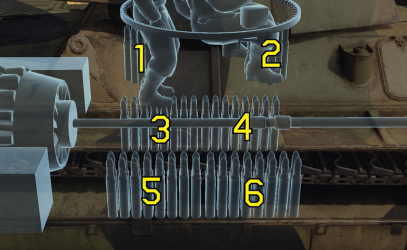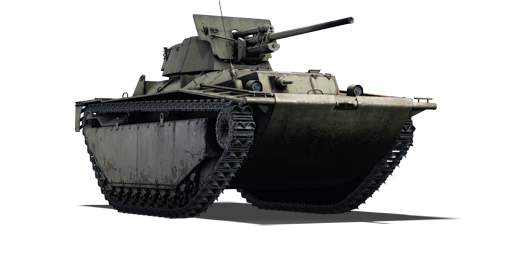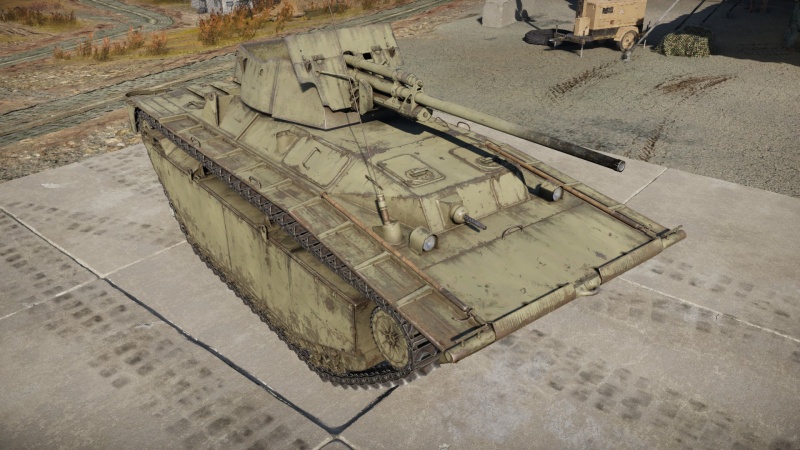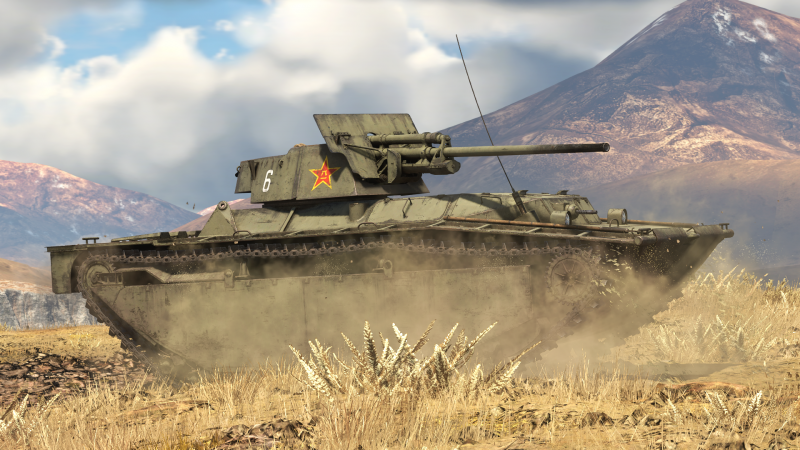LVT(A)(4) (ZiS-2)
| This page is about the light tank LVT(A)(4) (ZiS-2). For other versions, see LVT (Family). |
Contents
Description
The Amphibious Vehicle, Tracked, Armoured, Mark 4, 57 mm ZiS-2 - LVT(A)(4)(ZiS-2) is an up-gunned modification of the LVT(A)(4), which is the fourth armoured, infantry support variant of the Amphibious Vehicle, Tracked - LVT. The LVT(A)(4)(ZiS-2) was modified by the Chinese People's Liberation Army, which was based on the LVT(A)(4). During the Chinese Civil War, the Chinese Nationalist Army deployed a large number of LVT(4)s and LVT(A)(4)s. Following the defeat of the Chinese Nationalist Army in 1949, the Chinese People's Liberation Army captured many of the LVT(4)s and LVT(A)(4)s. The Chinese People's Liberation Army removed the original turret mounting the 75 mm M2 howitzer and replaced it with the high-velocity 57 mm ZIS-2 anti-tank gun for dual anti-tank and infantry support purposes after the US stopped supplying ammunition for the original LVT(A)(4) to China after the Chinese Civil War ended.
Introduced in Update 1.91 "Night Vision", the LVT(A)(4) (ZiS-2) will provide Chinese Army ground forces players with a very unusual tank that combines U.S. and Soviet philosophies. Despite its light armour, the LVT(A)(4) (ZiS-2) proved to be a formidable opponent when matched against opponents of similar ranks. The high-velocity 57 mm ZiS-2 anti-tank gun allows players to engage opponents from a significantly greater range than the original LVT(A)(4). The tank, however, is extremely vulnerable to aircraft strafing and artillery hits because of its high profile and open-top turret.
General info
Survivability and armour
The LVT's large and spacious hull might seem to make it difficult to knock out all of its crew, but that's only true when you are getting shot from the side. From your side, there is a huge empty area between the driving compartment and the fighting compartment that will absorb any shell, regardless of their explosive fillers. However an experienced player will know to shoot at these two compartments and avoid the empty space. From the front, the spacious hull does not help to keep the crew safe as a penetrating shell will travel through the empty space and hit any crew at the back, so you could die sooner than you expected. Avoid tanks with solid shots, for example British/Swedish tanks.
Armour type:
- Rolled homogeneous armour
- Cast homogeneous armour (Gun mantlet, Machine gun shield)
| Armour | Front (Slope angle°) | Sides | Rear | Roof |
|---|---|---|---|---|
| Hull |
12.7 mm (31°) Front plate |
6.35 mm (11-51°) Top |
6.35 mm (0-62°) | 6.35 mm |
| Turret |
38 mm (10°) Turret front |
25 mm | 25 mm | N/A |
Notes:
- Suspension wheels and tracks are 15 mm thick.
- Front hull has flat armour area where driver & co-driver sits.
Mobility
| Game Mode | Max Speed (km/h) | Weight (tons) | Engine power (horsepower) | Power-to-weight ratio (hp/ton) | |||
|---|---|---|---|---|---|---|---|
| Forward | Reverse | Stock | Upgraded | Stock | Upgraded | ||
| Arcade | 44 | 6 | 18.3 | 355 | 477 | 19.4 | 26.07 |
| Realistic | 40 | 5 | 221 | 250 | 12.08 | 13.66 | |
The LVT's mobility is adequate. On hard surfaces it easily reaches its top speed of around 38 km/h. On soft surfaces it needs more time to accelerate, and the top speed is lowered. The hull traverse is great, allowing you to quickly change direction, however a downside is that when you turn the hull to aim, you might over-turn and swing the gun past the target, increasing the aiming time which can be fatal.
Due to its big and tall tracks, the LVT can drive over some obstacles that are too tall for normal-sized tanks.
Modifications and economy
Recommended research order:
- Parts and FPE to increase post-penetration survivability
- Horizontal drive to better the main gun's traverse speed
- Adjustment of Fire and Elevation Mechanism to further improve gun targeting speed and accuracy
- Mobility modifications & others
- BR-271K, it's the least important as the stock round is already very powerful against all tanks
Armaments
Main armament
The LVT(A)(4) (ZiS-2) is armed with a 57 mm ZiS-2 cannon. This cannon provides excellent firepower: the horizontal gun traverse of ±25° gives it a total of 50° traverse angle to the left and right, covering a large arc at the front which is generally enough to deal with most frontal engagements, reducing the need to traverse the hull. The vertical gun traverse of -5°/+15° is average, but considering that this LVT has its gun mounted high on top of a tall chassis, -5° gun depression will feel lacklustre in hilly environment. Sometimes though, the LVT(A)(4) (ZiS-2) can fire over some covers where other tanks cannot shoot over since it is so tall.
The gun rotation speed is around ~8°/s which is adequate when using this tank as a mid to long range (400-1,000 m) support vehicle or tank destroyer, but will be quite slow if using it for close quarter combat within 400 m. This makes it challenging to target fast vehicles like BT-5, M22, AB 41, etc. The reload rate of ~8 seconds is average but will feel slow if a large group of enemies is to be engaged. The cannon's trajectory is very flat for a WW2 tank and thus becomes beginner friendly to perform distant shots. When using the LVT(A)(4) (ZiS-2) as a mid/long range vehicle, the 3.5x gunsight zoom will be somewhat inadequate as the target a few hundred metres away will appear very small making it hard to aim precisely.
| 57 mm ZIS-2 | Turret rotation speed (°/s) | Reloading rate (seconds) | |||||||||||
|---|---|---|---|---|---|---|---|---|---|---|---|---|---|
| Mode | Capacity | Vertical | Horizontal | Stabilizer | Stock | Upgraded | Full | Expert | Aced | Stock | Full | Expert | Aced |
| Arcade | 76 | -5°/+15° | ±25° | N/A | 10.6 | 14.6 | 17.8 | 19.6 | 20.9 | 8.7 | 7.7 | 7.1 | 6.7 |
| Realistic | 7.1 | 8.4 | 10.2 | 11.3 | 12.0 | ||||||||
Ammunition
- The stock BR-271 APHEBC shell performs excellently with its great penetration of ~143 mm and 21.5 g explosive filler. As such it can easily penetrate all tanks around this BR from the front, and cripple or destroy them with a single shot. The shell will follow a straight trajectory at a high velocity meaning it is a great long range weapon.
- The researchable BR-271K APHE shell has similar close-range penetration, velocity, and trajectory. It has a tiny bit more explosive filler (27.7 g) with a trade-off of a little worse ricochet angle and poorer long-range penetration. Thus the stock round will be effective for the great majority of the time.
- The O-271 HE shell is ineffective against conventional tanks due to its small explosive filler of only 220 g. Its blast and shrapnel are only useful when landing next to unarmoured vehicles like GAZ-AAA (DshK), Sd.Kfz 6/2, Chi-Ha LG, 15cm sIG 33 B Sfl, etc. It is not recommended to bring more than 4 of these rounds, as your hull MG can also finish the exposed crews on these vehicles.
| Penetration statistics | |||||||
|---|---|---|---|---|---|---|---|
| Ammunition | Type of warhead |
Penetration @ 0° Angle of Attack (mm) | |||||
| 10 m | 100 m | 500 m | 1,000 m | 1,500 m | 2,000 m | ||
| BR-271 | APHEBC | 145 | 142 | 128 | 112 | 98 | 86 |
| BR-271K | APHE | 145 | 140 | 118 | 95 | 77 | 63 |
| O-271 | HE | 12 | 12 | 10 | 8 | 6 | 5 |
| Shell details | ||||||||||||
|---|---|---|---|---|---|---|---|---|---|---|---|---|
| Ammunition | Type of warhead |
Velocity (m/s) |
Projectile mass (kg) |
Fuse delay (m) |
Fuse sensitivity (mm) |
Explosive mass (TNT equivalent) (g) |
Ricochet | |||||
| 0% | 50% | 100% | ||||||||||
| BR-271 | APHEBC | 990 | 3.14 | 1.2 | 9 | 21.56 | 48° | 63° | 71° | |||
| BR-271K | APHE | 990 | 3.14 | 1.2 | 9 | 27.72 | 47° | 60° | 65° | |||
| O-271 | HE | 700 | 3.72 | 0.4 | 0.1 | 220 | 79° | 80° | 81° | |||
Ammo racks

| Full ammo |
1st rack empty |
2nd rack empty |
3rd rack empty |
4th rack empty |
5th rack empty |
6th rack empty |
Visual discrepancy |
|---|---|---|---|---|---|---|---|
| 76 | 71 (+5) | 65 (+11) | 49 (+27) | 33 (+43) | 17 (+59) | 1 (+75) | No |
Machine guns
The LVT(A)(4) (ZiS-2) has a hull-mounted 7.62 mm M1919A4 machine gun. This MG has a large 250-round belt providing great continuous fire. It has an average vertical traverse of -10°/+20° and horizontal traverse of ±15°. Due to its horizontal traverse being smaller than that of the main gun, this MG sometimes will not be able to shoot at where the main gun is aiming, and the player must turn the hull to acquire the target within the MG's traverse if they want to use the MG. Having poor penetration of less than 14 mm, the M1919 is only potent against exposed crew like on trucks and some SPGs (e.g. CCKW 353, 15cm sIG 33 B Sfl). It cannot damage lightly armoured vehicles like an M2 Browning does since most of these vehicles have gunshields with at least 10 mm thickness which is enough to stop the M1919's bullets.
| 7.62 mm M1919A4 | ||||
|---|---|---|---|---|
| Mount | Capacity (Belt) | Fire rate | Vertical | Horizontal |
| Hull | 3,000 (250) | 500 | -10°/+20° | ±15° |
Usage in battles
The LVT(A)(4) (ZiS-2) is a fragile tank with a strong bite. The main gun is a very powerful Soviet ZiS-2 that have no problem penetrating through the hardest of enemies at its BR. Despite its size, it has great manoeuvrability that works on most terrain. Its high profile makes it a easy target for enemies to spot from afar and behind objects, fences and hills. The LVT(A)(4)'s thin hull armour makes it vulnerable to machine gun and autocannon fire. This makes Self Propelled Anti-Air vehicles and vehicles with 20 mm automatic cannons a lethal enemy, and large calibre guns with HEAT and HE can easily penetrate the thin armour and overpressure the LVT(A)(4).
The LVT(A)(4) (ZiS-2) has decent speed and is manoeuvrable enough to handle close combat with even while lacking a full 360° traversable turret. But to best counter the most dangerous of enemies is to utilize the long gun to its advantage.
You should memorise certain spots on different maps to make the most out of your amazing firepower. Pick spots that:
- Overlook a key passageway/street
- Are not too close or too far from the frontline
- Have hard cover/slopes around
- Are mostly flat (as your gun depression is bad and gun is mounted very high)
- Have some vegetation, if possible
This way you can sit at a comfortable spot, stay away from most dangers and target opponents that appear. The rather flat trajectory of your gun does not require as much elevation when shooting at distant targets which is beginner friendly, however the shell velocity is not fast, so you have to lead more than you think for moving targets. Because this is a sniper's tactic, if you are to bush up for better concealment, it is recommended to stack all bushes onto the upper front of the LVT. This is because you will mostly face targets from one direction only (your front) so you just have to cover up the front. The lower glacis does not need as much bush as it will usually get blocked by vegetation on the ground, acting as natural camouflage.
Enemies worth noting:
M4A3 (105): this low-tier Sherman is one tough tank to destroy, but luckily your LVT is one of the few that can destroy it with ease (most of the time). Within 500 m, your default shell can easily penetrate its frontal/side armour with an appropriate angle. You can also penetrate its turret between the edge of the gun mantlet and the gun barrel. A penetrating shell is very likely to knock out most of its crew. However, when it's angling, hull down, or >500 m away, either aim really carefully at the turret or wait until it reveals other weak spots (e.g. side). Note that you will be easily destroyed with overpressure by its HE or HEAT shells so avoid getting hit by it.
Pz.II/Flakpanzer 38: these German 20 mm cannons are a huge threat to the LVT since they can easily tear through the thin armour even at longer distances. Their high rate of fire also means that they can quickly knock out the LVT's crew or disable multiple critical components like the huge transmission and engine. But these vehicles are fairly easy to knock out with a single shot from your powerful 57 mm cannon.
Against the LVT(A)(4) (ZiS-2)
- Light tanks & SPAAs: light vehicles (e.g. M2A4, Pz.35(t), Strv m/31, etc) usually have limited post-penetration damage and can therefore struggle to destroy large tanks like the LVT. To effectively engage an LVT, you must memorise all of its crew's locations. If the LVT(A)(4) (ZiS-2) is facing you, shoot at the right side of its turret to disable its gunner, or shoot at its completely exposed gun breech to disarm it. You can also hit its flat gunshield with your MG if within 100 m as it is only 5 mm. Then use your quick reload to knock out its driver on the right side of the frontal hull, then go after the remaining crew. If the LVT(A)(4) (ZiS-2) is facing away from you, make sure that you are not within its horizontal aiming arc, then disable its driver or engine. Then finish off the rest of the crew. If you are caught from a distance but your tank is very fast (e.g. M22, BT-5) try driving at full speed and chance course randomly, the LVT(A)(4) (ZiS-2) has slow gun aiming speed and can struggle to keep its gun on you.
- Medium tanks & heavy tanks & tank destroyers: these vehicles such as M4, B1 bis, Marder III have better armour and/or firepower. Still, their armour cannot withstand a direct hit from the LVT(A)(4) (ZiS-2)'s deadly cannon. If you must make a move, try exposing the frontal armour of your tank at an extreme angle to ricochet the LVT's 57 mm shell, then go out of cover and return fire as it reloads. Since most of these tanks have reload speeds slower than light vehicles, you must make your shots count: don't shoot at the area below the turret if it's a side shot as there is absolutely nothing inside there. The crew are all located inside the turret and the front driving compartment.
Pros and cons
Pros:
- Very powerful cannon for its BR: 145 mm penetration can effectively go through any tank frontally, even in an uptier; upon penetration the 20 g TNT does a great job at finishing off most, if not all the crew
- Good mobility
- Somewhat fast, and has great hull traverse and manoeuvrability
- Is amphibious, meaning it can launch surprise attacks using rivers and lakes
- Five crew members with huge space between them increases survivability, especially against small-calibre guns with little explosive filler
- Sloped turret sides can lead to some shells bouncing
- When moving on calm waters the gun will get a stabilizer effect, this will allow firing on the move
Cons:
- Poor Survivability
- Massive hull means a huge silhouette, rather easy to spot and hit
- Very thin armour, can be penetrated by any cannon/heavy MG
- Easily destroyed with overpressure by large-calibre HE and HEAT rounds
- The crew in the open-topped turret are very close together, meaning they can be taken out in a single shot or by aircraft
- Below-average 5° gun depression plus the tall hull makes it quite difficult to fight in hilly terrain
- Very slow reverse speed can prevent it from retreating back to cover in time
- The turret is unable to rotate 360°
- Poor zoom of the gunsight makes it hard to see and aim at distant targets
- no low-speed stabilizer unlike the LVT(A)(1)
History
The LVT series of tracked amphibious vehicles originated from a pre-war civilian design, the Alligator hurricane rescue vehicle which had been designed by Donald Roebling (1908-1959) in 1935. An article on a further development of this vehicle in 1937 caught the attention of the US Marine Corps, but initially the proposal of militarising the Alligator met resistance both from the US Navy, who felt conventional landing craft could do the job just as well, and from Roebling himself, who disliked the idea of his vehicle being used for military purposes. The outbreak of war in Europe persuaded Roebling into building it anyway, and by May of 1940 he had completed a militarised prototype, which was tested in November 1940 and subsequently approved for production.
Even before the first prototype had been tested, Roebling had started designing a turret-equipped armed version of his LVT, intended for providing fire support for landings. Originally the design languished, but in June of 1941 the USMC recommended the development of a fire support version of the LVT. Development of this variant was slow, as the entire LVT had to be redesigned: light armour was added to the hull and a 37 mm armed turret similar to that of the M3 Stuart light tank was mounted on top, resulting in the initial fire support variant, the LVT(A)(1).
Combat experience with the LVT(A)(1) soon showed that the 37 mm gun was insufficient for fire support purposes, so the original M3 Stuart turret was replaced by that of a 75 mm Howitzer Motor Carriage M8, creating the LVT(A)(4) variant, of which 1890 were built. Of these, several dozen were delivered to Nationalist China under the Lend-Lease Agreement.
In KMT service, the LVT(A)(4) ended up being used both against the Japanese forces during World War II, as well as against the PLA during the ensuing civil war. Most of them eventually fell into PLA hands. The lack of western supplies meant that ammo soon became sparse for the 75 mm M3 Howitzer gun mounted by the LVT(A)(4); to keep them useful as well as to bolster the number of available armoured vehicles in the PLA inventory, the LVT(A)(4)s were locally converted to either accept the 37 mm M6 tank gun - essentially retrofitting them to LVT(A)(1) status - or the 57 mm ZiS-2 anti tank gun - identical to the gun used on the ZiS-30 tank destroyer, and technically similar to the ZiS-4 gun used on both the T-34-57 and the SU-57B.
The haphazard way in which these conversions took place, as well as the lack of official documents on them, make it unclear how many LVT(A)(4)s were converted. The lack of available spares for their automotive components makes it unlikely that they were used for long, and it is likely they were withdrawn from frontline use as soon as Soviet deliveries of tanks and armoured vehicles started in the early 1950s.
Media
- Skins
See also
- LVT(A)(4) ZIS-2 (USA) - Identical gift vehicle in the US tree
External links
Paste links to sources and external resources, such as:
- topic on the official game forum;
- other literature.
| Food Machinery Corporation (FMC) | |
|---|---|
| Amphibious AFVs | LVT(A)(1) · LVT(A)(4) |
| IFVs | M3 Bradley · M3A3 Bradley |
| China tank destroyers | |
|---|---|
| PLA | |
| Gun vehicles | PLZ83 · PLZ83-130 · PTZ89 |
| Missile vehicles | AFT09 |
| ROC | |
| Missile vehicles | CM25 |
| USA | |
| Gun vehicles | ␗M8 HMC · LVT(A)(4) (ZiS-2) · ␗M10 GMC · ␗M36 GMC |
| Missile vehicles | ␗M113A1 (TOW) |
| USSR | |
| Gun vehicles | ␗SU-76M · ␗ISU-152 · ␗ISU-122 · ␗SU-100 |






